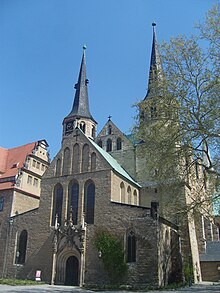Thietmar of Merseburg
Thietmar (also Dietmar or Dithmar; 25 July 975 – 1 December 1018),
Life

Thietmar was a son of the Saxon count
Baptized in
Thietmar witnessed the struggles of the young Ottonian king Otto III and his mother Theophanu to secure their reign. He took some part in some political events of the time; in 994 he was a hostage in the hands of the Norsemen, and he was not unfamiliar with the actualities of war.[1] Upon the death of his parents, he inherited large parts of the Walbeck estates and in 1002 became provost of the family monastery, established by his grandfather Count Lothair II. On 21 December 1004, he was ordained as a priest by Archbishop Tagino of Magdeburg.
In 1009, through the intercession of Archbishop Tagino, he became Bishop of the Merseburg diocese, which had been re-established by King
Thietmar's Chronicle
This section needs additional citations for verification. (August 2022) |

Between 1012 and 1018 Thietmar, while Bishop of Merseburg, composed his chronicle Chronicon Thietmari, which comprises eight books,
The first three books, covering the reigns of Henry I and the first two Ottos (
The Latin style and the composition are not of a high standard, largely because, as the original manuscript reveals, Thietmar continued to make amendments and insertions to the text after it was completed. Nor does he always discriminate between important and unimportant events.[citation needed]
The chronicle is nevertheless an excellent source for the history of Saxony during the reigns of the emperors Otto III and Henry II. No information is excluded by Thietmar, but the fullest details refer to the Bishopric of Merseburg, and to the wars against the Wends (Polabian Slavs) and the Poles.[citation needed]
The original manuscript was moved in 1570 to
Thietmar's statement that the
Editions and translations of Thietmar's Chronicle
Thietmari Merseburgensis episcopi Chronicon:
- Holtzman, Robert (ed.) and J.C.M. Laurent, J. Strebitzki und W. Wattenbach (trs.). Die Chronik des Thietmar von Merseburg. Halle, 2007 (1912). ISBN 978-3-89812-513-0. New publication based on earlier editions and German translations and including 48 illustrations by Klaus F. Messerschmidt.
- Holtzmann, Robert (ed.). Die Chronik des Bischofs Thietmar von Merseburg und ihre Korveier Überarbeitung. MGH Scriptores rerum Germanicarum NS 9. Berlin, 1935. Available from digital MGH
- Wattenbach, Wilhem and Friedrich Kurze (eds.). Thietmari Merseburgensis episcopi Chronicon. MGH Scriptores rerum Germanicarum in usum scholarum separatim editi 54. Hanover, 1889. PDF available online from the Internet Archive.
- Lappenberg, J.M. (ed.). "Thietmari Chronicon a 919-1018." In Annales, chronica et historiae aevi Saxonici, ed. Heinrich Pertz. MGH Scriptores (in Folio) 3. Hanover, 1839. 723–871. Available online Archived 2018-02-20 at the Wayback Machine
- Warner, David A. (tr.). Ottonian Germany. The Chronicon of Thietmar of Merseburg. Manchester, 2001. ISBN 0-7190-4925-3. English translation.
- Trillmich, Werner (tr.). In Thietmar von Merseburg. Chronik. Ausgewählte Quellen zur Deutschen Geschichte des Mittelalters vol 9. 8th ed. Darmstadt: Wissenschaftliche Buchgesellschaft, 2002 (1957). ISBN 3-534-00173-7. Translation into modern German.
- Holtzmann (tr.). 1938. GdV, 4.Aufl. German translation.
- von Laurent (tr.). 2. Aufl. Berlin, 1879. German translation.
- Komarnicki, Z.E.T. (tr.),Kronika Dytmara, Biskupa Merseburgskiego jako jedno z najdawniejszych świadectw historycznych o Polsce.... Ksiegarni Jana Hussarowskiego, Żytomierz, 1861. Polish translation.
References
Attribution:
- This article incorporates text from a publication now in the public domain: Chisholm, Hugh, ed. (1911). "Thietmar of Merseburg". Encyclopædia Britannica. Vol. 26 (11th ed.). Cambridge University Press. p. 849.
 This article incorporates text from a publication now in the public domain: Ott, Michael (1909). "Dithmar". In Herbermann, Charles (ed.). Catholic Encyclopedia. Vol. 5. New York: Robert Appleton Company.
This article incorporates text from a publication now in the public domain: Ott, Michael (1909). "Dithmar". In Herbermann, Charles (ed.). Catholic Encyclopedia. Vol. 5. New York: Robert Appleton Company.
Further reading
- Thietmar of Merseburg in the German National Library catalogue
- "Digitale Edition der Chronik des Thietmar von Merseburg". MGH-Bibliothek (in German). 2002, by Arno Mentzel-Reuters and Gerhard Schmitz, with the facsimile of the Dresden MS and Holtzmann's 1935 edition.
- "Thietmari Merseburgensis episcopi chronicon - notae Germano sermone scripta Latino" (in Latin).
- "Vita Operaque by Migne Patrologia Latina" (in Latin).
- Wilhelm Wattenbach (1894), "Thietmar", Allgemeine Deutsche Biographie (in German), vol. 38, Leipzig: Duncker & Humblot, pp. 26–28
- "Thietmar of Merseburg". Repertorium "Historical Sources of the German Middle Ages" (Geschichtsquellen des deutschen Mittelalters).
